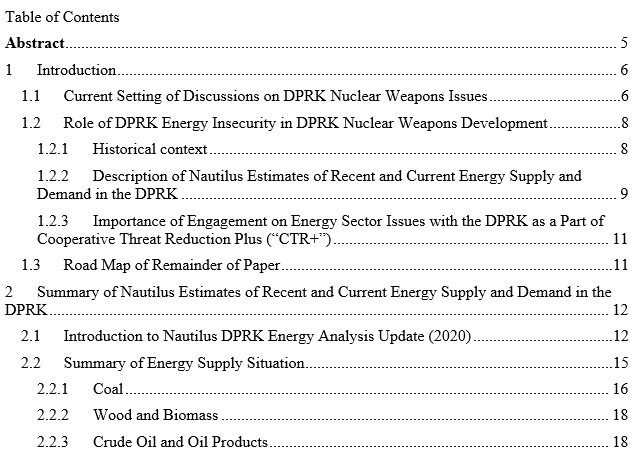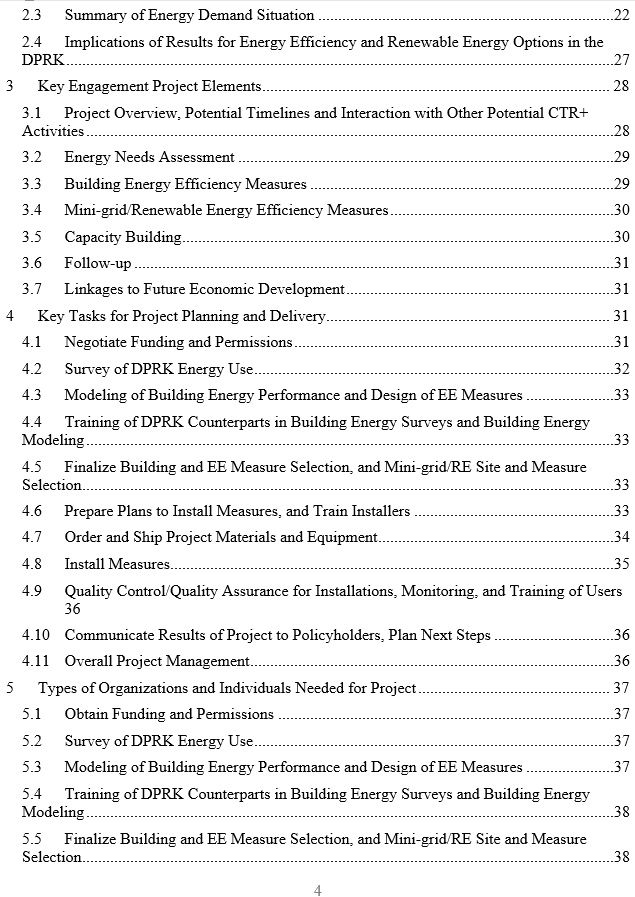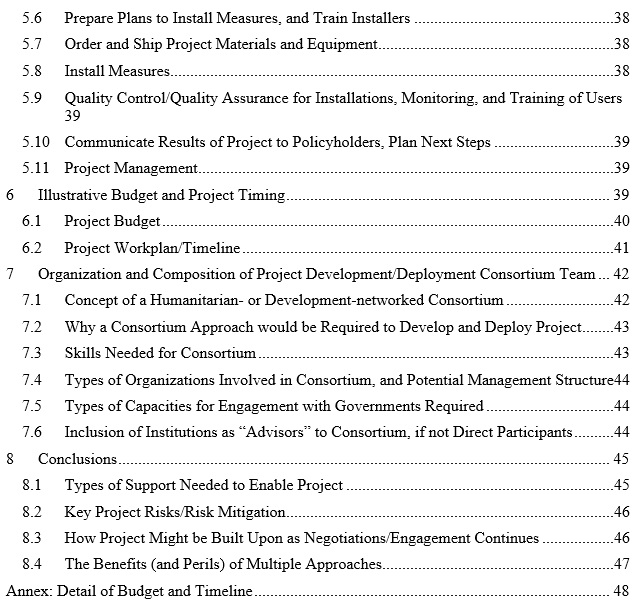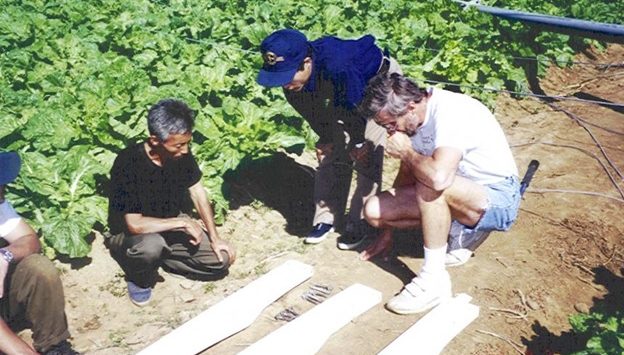DAVID VON HIPPEL AND PETER HAYES
MAY 10 2021
I. INTRODUCTION
In this Special Report, David von Hippel and Peter Hayes describe a consortium model to deliver humanitarian engagement project in the Democratic People’s Republic of Korea (DPRK) that focuses on energy efficiency and renewable energy technologies and supporting measures to fill the need for cooperative threat reduction as the international community engages the DPRK in discussions on nuclear weapons and related issues.
Excerpts of the full study are below. The full report may be downloaded here [1.6MB PDF]. The report was first published by the Asia Pacific Leadership Network here.
David von Hippel is a Nautilus Institute Senior Associate. Peter Hayes is Director of the Nautilus Institute and Honorary Professor at the Centre for International Security Studies at the University of Sydney.
The views expressed in this report do not necessarily reflect the official policy or position of the Nautilus Institute. Readers should note that Nautilus seeks a diversity of views and opinions on significant topics in order to identify common ground.
This report is published under a 4.0 International Creative Commons License the terms of which are found here.
Banner image: Image from Nautilus Humanitarian Wind Power Project in Unhari, DPRK, September, 1998. Photo by D. von Hippel.
II. NAPSNET SPECIAL REPORT BY DAVID VON HIPPEL AND PETER HAYES
US-DPRK CTR+: PROVISION OF HUMANITARIAN ENERGY EFFICIENCY, RENEWABLE ENERGY, AND MICRO-GRID MEASURES TO THE DEMOCRATIC PEOPLES’ REPUBLIC OF KOREA (DPRK) FOR COOPERATIVE THREAT REDUCTION
MAY 10 2021



Summary
A key reason for the Democratic Peoples’ Republic of Korea’s (DPRK’s) development of nuclear weapons and missile systems has been the DPRK’s energy insecurity, that is, its lack, since the breakup of the Soviet Union, of access to key fuels—particularly crude oil, oil products, and electricity—at affordable prices and in sufficient quantities to develop its economy. A consortium-led humanitarian/capacity-building/engagement project, focusing on the installation of energy-efficiency measures in the Democratic People’s Republic of Korea (DPRK) buildings sector and mini-grid systems powered by renewable energy for electricity generation, could potentially be deployed rapidly and would meet the requirements of a substantial pilot engagement project that would contribute toward cooperative threat reduction on the Korean Peninsula. The project would offer positive attributes such as highly visible symbolic improvements for the DPRK energy sector, consistency with DPRK stated interests, limited potential for military diversion, affordability, scalability, humanitarian and economic development elements, and large scope for face-to-face interactions between North Koreans and the international community. It would also provide a demonstrable model for both future direction in the DPRK energy sector and for productive and cooperative future engagement between the parties as they work toward threat reduction. For such a project to be deployed rapidly, it is likely that a consortium of third parties—that is, non-governmental organizations—in the international community will need to plan, organize, and deliver the project, albeit, of course, with the approval and support of the governments involved. The report that follows provides a summary of the authors’ estimates of DPRK energy supply and demand, an appreciation for which is important in understanding what the goals of and challenges faced by a cooperative project would be, followed by an illustration of what the project might include, how it might be organized, what organizations and skills would be needed, and an example project budget and timeline, plus thoughts on the types of organizations might be involved in a project consortium, and overall conclusions.
1. Organization and Composition of Project–Development/Deployment Consortium Team
Fielding a project like that described above in a DPRK setting will be a unique undertaking. As described above, project success will require the experience and skills of a networked consortium of diverse organizations and individuals, communicating clearly and frequently
1.1 Concept of a Humanitarian- or Development-networked Consortium
A humanitarian- or development-networked consortium would be assembled solely for the purpose of implementing funded projects in the DPRK as part of engagement activities related to addressing tensions on the Korean Peninsula and beyond. As such, it should not be the aim of the consortium to establish an on-going social or commercial presence in the DPRK, rather to be a vehicle for carrying out complicated international projects in an efficient and transparent manner that reports and receives input from all parties but is not under the control of any individual government.
As such, a consortium approach is required to develop and deploy substantial technical assistance in the DPRK rapidly for a major project, due in large part to the variety of skills and experience needed to carry out the project.
Even if it is funded principally by a ROK agency or NGO, it should be noted that the consortium might need to include mostly non-ROK participants in order to secure DPRK approval, at least for an initial period (probably lasting years) while DPRK/ROK negotiations and rapprochement are in process.
1.2 Why a Consortium Approach would be Required to Develop and Deploy Project
A consortium approach will be needed for this project due to the challenges in working in the DPRK in general, and the challenges specific to working in the DPRK to deploy a pilot project in the context of denuclearization efforts. Some of the challenges for working in the DPRK range from logistical challenges such as lack of local materials and problems in moving materials from place to place, to organizational challenges associated with working in multiple DPRK agencies that do not normally interact much (a problem not unique to the DPRK), with lines of authority that cross and individuals who may be very sensitive to how their actions and decisions are perceived by superiors. A consortium approach is also necessary in order to deploy substantial technical assistance in the DPRK for a major project, because the skills needed, ranging from supplying academic training to on-the-ground installation of EE and RE measures, will be beyond the scope of most any individual organization, and because many different countries and groups within countries will have major political and (eventually) economic stakes in the project outcome.
1.3 Skills Needed for Consortium
The consortium will need a mix of skills and organizational capacities, and will need to be composed of individuals and organizations of acceptable (mostly to the DPRK, but also to other stakeholders) national origins to make working in the DPRK relatively smooth from inception in a rapid humanitarian and development project. As such, the project will require energy efficiency and renewable energy technical skills at the planning, training, and implementation levels, diplomacy skills, experience working with DPRK officials, technicians, and other DPR Korean counterparts, economic development experience, logistical skills, and organizational and management skills, as well as many other capabilities.
The authors have not yet made an significant study of models for consortium-led projects that may be applicable to the rapid deployment EE/RE DPRK project described here, but the literature does include a number of examples where consortium-based approaches have been deployed, for example, for emergency aid provision following natural disasters,[1] war zone recovery,[2] or other initiatives. The process of assembling a proposal for funding for the project described here should include a review of the lessons learned in carrying out these previous consortium-led aid efforts.
1.4 Types of Organizations Involved in Consortium, and Potential Management Structure
The consortium will have a mix of non-profit and for-profit contractor firms and institutions, including a consortium “convener” or “management team”, which might be a private firm, skilled in assembling and running such a group.
1.5 Types of Capacities for Engagement with Governments Required
For the project to succeed, the project consortium will need to have groups and individuals with the diplomatic capacities and political connections to engage each of the nations that have a stake in resolving conflict issue on the Korean peninsula. This would include, for example, each of the “six parties” previously involved in talks (the US, Russia, China, the ROK, the DPRK, and Japan), as well as European authorities, both national and Europe-wide. One or more consortium members will need to have the capacity to engage various supplier countries, as well as to work with sanctions review and licensing agencies, especially in the US.
1.6 Inclusion of Institutions as “Advisors” to Consortium, if not Direct Participants
Inclusion of key national and international institutions as advisors to the project consortium, even if those institutions are not direct participants in the project, would likely be beneficial for both the initial project and to plan/fund follow-on development. Whether through a formal role on the Advisory Committee or as informal advisors, staff from major intergovernmental organizations (IGOs), multilateral development lenders, and bilateral aid agencies could advise or serve as representatives in consortium management.
Examples of such institutions might include UNDP, the World Bank, ADB, possibly the Chinese Exim Bank and likely also KOICA (the ROK’s Korea International Cooperation Agency), and national and international European Union aid organizations. Involving such organizations in the project early-on, even if they do not contribute to funding for the pilot project (which they likely wouldn’t, for a rapid deployment effort), would pay dividends when it is time to build on the success of the project to continue and expand economic development/engagement activities with the DPRK.
2. Conclusions
Nautilus Institute’s experience in working with the DPRK delegations and in the DPRK has included the following insights:
- It is important to design projects that can be built upon with future engagement activities, also that also can be used as models for peaceful redevelopment activities by the DPRK itself.
- Good projects should start relatively small, so as to be tractable for initial funding and deployment while experience is gained, but should be scalable based on needs and funds available.
- Good projects should be designed to build and take advantage of the growing technical/organizational capacity of DPRK partners. These capabilities can be expected to growth through the participation of individuals from the DPRK in engagement activities, but also as a result of the gradual uptake of new technologies into DPRK society as its economy becomes more market oriented.
- Good projects should meet the needs of several different DPRK constituent groups, as well as the needs of project participants and supporters in ROK and elsewhere.
- Good projects should be constructed so as to contribute toward peaceful, sustainable improvements in the DPRK economy.
These insights should be taken into account when developing and undertaking the type of consortium-led, rapid EE/RE CTR+ engagement project discussed here. In addition, below we discuss the types of support that will be needed to enable the project, key project risks and how those risks might be mitigated, how the project might be built upon as negotiations continue, and the benefits and perils of mounting multiple engagement projects.
2.1 Types of Support Needed to Enable Project
In order to be successful, a consortium-led, rapid EE/RE engagement project in and with the DPRK will require support from the international community, certainly meaning through funding and in-kind contributions, but also in terms of political support to enable the project to move forward in a timely fashion, and to encourage the right partners to participate in the project.
Potential sources of funding for the project include ROK institutions and foundations, US/European foundations, and other donors. Funders must, however, be willing and able to move rapidly so that opportunities to move forward with the project can be captured before the political impetus to do so wanes (or reverses).
Similarly, key organizations in the nations in the international community that are involved in discussions with the DPRK geared toward addressing its nuclear weapons program and tensions on the Peninsula must likewise be willing to move rapidly to address or ease barriers in their own nations that might stymie the project. These barriers may include direct “red tape” (licensing and permit requirements) that keeps the project from being rapidly developed and implemented, regulations or perceived biases that might keep capable potential consortium members and/or experts with skills needed by the project from joining the project, and domestic political obstacles that may not be directly related to the project, but which affect the level of support for the project that leaders can provide.
2.2 Key Project Risks/Risk Mitigation
As with any project involving the DPRK, and, indeed, most development-oriented projects in many countries, there are several risks that may keep the project from succeeding or delay project implementation or completion. These risks include, but are certainly not limited to:
- Delays in obtaining the necessary approvals (tacit and/or official) from governments;
- Delays in obtaining adequate funding (and/or that funding will be withdrawn if there is a shift in the political winds);
- Delays in assembling cooperation mechanisms with DPRK counterparts;
- Delays in material delivery through delays in ordering, customs delays, and/or transport/unloading delays;[3] and/or
- Delays due to disruption in support in one or more stakeholder nations due to political events (sometimes not directly related to DPRK issues, such as the needs of policymakers to appeal in a particular way to their domestic supporters at a particular time), elections, or international events that divert attention and funding to other venues.
Of these, delays in approvals and or in reaching agreement with DPRK counterparts may be reduced through good communications, logistical delays can be minimized through good planning and development of contingency plans, and the risk of project disruption by outside events can be reduced by attempting to insulate the project from politics by the mutual agreement of stakeholders. But no matter what risk reduction measures are implemented, risks of project disruption will still exist, and the consortium implementing the project will need to be ready to deal with disruptive events and circumstances when (probably not if) they occur.
2.3 How Project Might be Built Upon as Negotiations/Engagement Continues
The consortium-led, rapid engagement EE/RE CTR+ project described in this paper, depending on its success in implementation, might be built upon in many ways as negotiations between the DPRK and the international community, and engagement of the international community with the DPRK, continue. Just a few of the ways that the project might be built upon in the short- to medium-term include:
- Work with the DPRK to develop co-manufacturing of materials for further EE/RE applications (such as MgO board made in the DPRK from DPRK magnesia resources or expanded in-country assembly of solar PV panels), and related economic development.
- Work with the DPRK to develop related projects, such as electricity grid rehabilitation via (or including) broad dissemination of mini- and micro- grids based on renewable energy, and broader assessments of energy needs and implementation of energy and environmental planning (including sustainable development planning) in the DPRK.
- Apply the lessons learned during the project to make progress on long-standing energy interconnection proposals involving the DPRK, including electricity grid interconnections from the ROK through the DPRK to Russia and/or China and Mongolia, including linkages for improving the DPRK’s energy security (and reducing its energy insecurity) to foster future economic development and economic engagement with the Northeast Asia region and the international community.
- Seek opportunities to find meaningful employment for scientists and technicians currently working in nuclear and related fields in the DPRK as the DPRK nuclear weapons programs are gradually put under international supervision and wound down as engagement proceeds.
- Use the project as a springboard to cooperative activities in other areas, such as biodiversity corridors along the Korean Peninsula and across the demilitarized zone, as well as to further educational exchanges in the energy and environment sector and beyond.
2.4 The Benefits (and Perils) of Multiple Approaches
Although the rapid engagement EE/RE CTR+ project described here is designed to incorporate flexibility in the event that elements of the project do not go as planned, it will probably be wise to implement other engagement projects concurrently or nearly so, to offer successes that leaders can point to in the event that one of the projects, despite the best efforts of all involved, end up failing. Multiple different projects offer the benefit of involving more DPRK officials, technicians, and ordinary citizens with their counterparts on international team, but will add some complexity to negotiations. As a consequence, it may be that only a few projects can be pursued at any one time, until additional experience is gained in working with DPRK colleagues. In addition, there will be a tendency, at least at first, for DPRK officials to want to limit interactions between North Koreans and foreigners, which will in turn probably limit the number of projects that can be carried out.
III. ENDNOTES
[1] See, for example Sneha Krishnan (2017), “Humanitarian consortia approaches: evidence from Eastern India”, Environment & Urbanization. Vol 29(2): 459–476, available as https://journals.sagepub.com/doi/pdf/10.1177/0956247817718430.
[2] See, for example, Reliefweb (2018), “Access consortium launched new humanitarian programme to support over 120,000 conflict-affected people in Eastern Ukraine”, dated 12 Sep 2018, and available as https://reliefweb.int/report/ukraine/access-consortium-launched-new-humanitarian-programme-support-over-120000-conflict.
[3] Nautilus Institute’s Unhari humanitarian wind power project (which included missions to the DPRK in 1998 and 2000), for example, was very nearly delayed beyond recovery when the shipping container holding virtually all of the material and equipment for the project could not be off-loaded in the DPRK port of Nampo due to there being a very few working dockside cargo cranes at the time. Only heroic and politically muscular intervention by the main DPRK counterpart for the project convinced the port authorities to prioritize the unloading operation, which finally took place the day before the Nautilus team arrived at the project site.
IV. NAUTILUS INVITES YOUR RESPONSE
The Nautilus Asia Peace and Security Network invites your responses to this report. Please send responses to: nautilus@nautilus.org. Responses will be considered for redistribution to the network only if they include the author’s name, affiliation, and explicit consent


